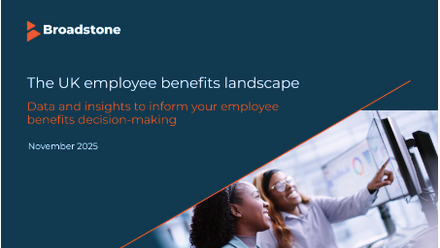10 key Q & As about added value group risk services

1) Why do group risk providers offer extra support services as part of the package?
Because today's group risk proposition focuses as much on prevention, early intervention and support as it does on paying claims. Employers are focusing more on the health and wellbeing of their employees, rather than only covering the cost of absence, and these extra support services complement employers' own health and wellbeing strategies.
2) What kind of extra support services do group risk providers offer?
Each provider will offer a blend of different services but, generally, group risk products offer up support such as Employee Assistance Programmes, HR and legal advice, second medical opinion services, online health assessments, mental health first aid training, absence management, occupational rehabilitation and fast track access to counselling and physiotherapy.
Increasingly, employers are recognising the value to their business of having a healthy and resilient workforce. Alongside this, group risk protection support is further evolving to encompass greater help for employers in managing the health and wellbeing of their workforce and encouraging better health behaviours.
3) Is there an extra charge for these services?
These services are usually offered at no additional charge and give employers the opportunity to make a saving (often significant) on comparable stand alone services they might already have in place or be considering in the future.
Proficient use of the extra support services will have the effect of reducing claims and thus premiums, so the extra services reduce costs rather than increase them. The services can be used every single day - even if a claim is never made - and can drive engagement, releasing money to spend elsewhere.
4) Which of these services offer the most benefit to employers?
Businesses will need to evaluate this for themselves or work with their adviser to understand how the benefits work best for them. For some, it might be the Employee Assistance Programme that is of greatest value to them whilst for others it might be the HR or rehabilitation support and advice. Forward-looking employers may see the extra support for health and wellbeing as a driver for them.
Effective use of these services will help improve productivity - the fact is, a contented and focussed workforce will drive a business forward. Group risk support services can help to deliver this.
5) How can employers access and get the most out of these services?
These valuable services can be accessed by HR staff, line managers and employees alike on a daily basis directly from the provider websites or through the employer's adviser's platforms. Getting the most out of them means using them as they are intended - every day – and, importantly, communicating them effectively to staff. This, in turn, can reinforce the position of a business as a caring organisation.
6) Does every business make full use of their extra support services?
GRiD's latest research puts utilisation rates for these services at around 50% (52.2% for group life, 47.7% for group income protection and 50.4% for group critical illness), so it would appear that although many employers do understand their value and are making efficient use of them, about half of them are missing out on these services. These are not services that are just for use when people go off sick - they support employers, line managers and employees on an everyday basis.
Our research results are encouraging and suggest that there is a growing appreciation among employers of their effectiveness. That said, there is clearly still work to be done to encourage a greater number of employers to take full advantage of these services.
7) How will using these services impact on absence/claims further down the line?
Group risk extra services can be extremely effective in keeping people in the workplace, giving them the help they need to make life changes and supporting them back to work.
As well as paying £1.26bn in claims during 2014 (£3.45 million a day), group risk providers helped more than 1,500 employees back to work within the first few months of absence through active intervention and support. To put this into context, this represents just under a third (29%) of the number of employees whose group income protection claim payments started in 2014.
Whilst this figure doesn't capture all those who returned to work (perhaps because their absence merely ran its course or they returned to work after receiving benefit payments for a period of time) a one in three return to work ratio is a real demonstration of how effective early intervention is and of the value group risk providers add beyond paying claims.
8) Will the roll out of the government’s Fit for Work service encourage employers to use group risk services more frequently?
Whilst accessing the government's new Fit for Work service is free, employers will bear the cost of implementing any recommendations made by the service so employers should always firstly consider what is already available to them through their group risk package.
Employers who have experience of the Fit for Work service (which won't help to implement recommendations or source treatment) will come to appreciate where group income protection in particular can better serve their needs by helping them implement back to work programmes and by giving them access to a raft of further support.
9) Should employers take account of the services on offer when selecting a group risk provider?
Efficient use of group risk extra support frees up both money and time to use elsewhere so employers should carefully consider what comes along with a group risk product and ensure that this has as much consideration as the actual cost of the insurance.
Crucially, added value group risk services are often available to the entire workforce and not just the insured population so looking at the overall value of the package rather than just focussing on the premium is key to effective use of budget.
10) How can providers and advisers help?
We all have a role to play in making sure employers are aware of what they are buying and how best to use it and that employees are able to access this help when they need to.
Providers and advisers can help employers to make informed purchases. And employers can help with the communication of these benefits to their employees. Better use of added-value services can be encouraged by working in a tri-partite relationship where roles and trigger points are mapped out and communication strategies are developed together in order to gain maximum outcomes from interventions and support for staff.
This article was provided by Group Risk Development (GRiD).
The Group Risk Employer Research study was undertaken in September 2015 among a sample of 501 UK businesses with between 5 and 1,000 employees. Research was conducted by Lightspeed Research for Group Risk Development (GRiD).
Follow Katharine Moxham on Twitter @KMoxham







